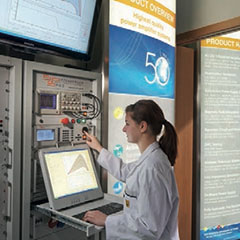A trusted name in the solar industry for decades – Spitzenberger & Spies GmbH & Co. KG. – remains ahead of the rest when it comes to the capabilities of modern bi-directional inverters. In this article, we explore the use of battery energy storage systems in local PV installations and testing the performance of connected solar inverters.
The longstanding problem when using photovoltaic energy harvesting is the night, when no energy production is available. Yet, several ways are currently being discussed to supply energy even during night-time with renewable energy.
One possibility for avoiding the nightly energy gap is an energy storage system. Centralized storage systems are already on the market, and are mainly driven by the power generating and distributing industry. For those solutions storage media like heat, gas, air and water are used. For smaller and decentralized installations like family houses new battery based storage systems are entering the market.
The functional idea behind a battery energy storage system is shown in Fig. 1 (opposite).
In this idea the solar inverter acts as a bi-directional gateway between the local installation and the public grid. A battery energy storage system is optimally connected to the PV installation on the DC side of the bi-directional solar inverter. The battery storage system can be charged either directly by using the DC generated from the PV installation or by using the AC/DC path of the bi-directional inverter connected to the public grid.
On the other hand the battery storage system can also supply the public grid with internally stored energy by using the DC/AC coupling path of the bi-directional inverter.
In installations with an uni-directional inverter – most of the existing installations are unidirectional – a rectifier unit needs to be connected for the conversion of the AC grid power into a DC power able to charge the connected battery storage system. From the harvesting point of view this installation has double losses, losses from the AC/DC conversion as well as the inverters losses when converting the DC back into AC.
So it is a matter of evaluation whether the connection of rectifier units makes sense or whether it is better to replace the uni-directional inverter with a bi-directional unit.
Which possibilities are on the market for evaluating the efficiency of solar inverters, rectifier units and bi-directional inverters?
The most important technical point to test, simulate and measure is the overall efficiency of such an installation and to optimize the characteristic of the bi-directional solar inverter.
With a battery simulation system like the BESS test system from Spitzenberger & Spies bi-directional solar inverters can be tested in many possible environment conditions and with many different types of storage batteries without having these storage batteries or without investing lots of money for having these battery systems available.
Not to be forgotten shall be the advantage to reproduce the charging and discharging characteristic of the different storage systems at any time.
How can this inverter efficiency be tested in practice?
In nearly all cases the optimum performance of the solar inverter is the main point talking about efficiency of the overall system.
Due to the changing load condition during the charge cycle, the inverters need to adjust the maximum power point to gain maximum performance.
The Spitzenberger & Spies BESS test system is an optional extension of an existing solar inverter test system. The functional principle of the BESS system is based on the battery model of Rincon-Mora.
See Fig. 2
The normal operation mode of the PV simulator is shown in Fig. 3. The bi-directional solar inverter’s input is connected to the PV simulator PVS and the AC output of the inverter is feeding energy into the grid simulator. The inverter converts DC to AC.
The multi-function PV simulator PVS can operate either as a generator / simulator of the PV installation or as battery simulator. Due to different types of solar generators, the PVS/BESS series has five voltage ranges: 400V / 500V / 600V / 800V / 950V.
Operating as a battery simulation system the bi-directional solar inverter is converting AC to DC (see Fig. 4). The inverter’s efficiency is depending on the battery characteristic of the connected battery system.
The simulation part of the software allows specifying the battery model parameters which are the input parameters of the battery characteristic in relation to the percentage of charge:
U0: the battery voltage
RS: the serial impedance
R1: the parallel impedance 1
R2: the parallel impedance 2
C1: the parallel capacitance 1
C2: the parallel capacitance 2
The PVS simulator acts during the test as a sink, consuming the energy produced by the solar inverter. Furthermore the technical specification of the battery storage system can be defined with the parameters:
Capacity (Ah)
Charging percentage at system
startup (%)
Maximum current capability (A)
Maximum voltage capability (V)
All this parameters are set in the systems controlling software application. This application is setting up the system and simulates the changing load conditions.
As a result, the software prints the voltage / current curve of the battery storage system during the charging cycle from 0-100%.
All manufacturers of bi-directional inverters can easily optimize their inverter characteristic for different battery types using the SPS battery simulation system.



























